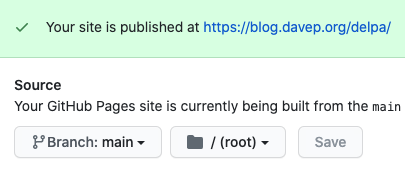About
This is delpa, a small personal package archive for GNU Emacs. It isn’t
intended as an alternative archive or anything like that, it’s simply an
archive of personal code that I host via GitHub pages so I can quickly and
easily set up or update a GNU Emacs installation.
Information on how this came about can be found in a blog post I wrote in April 2017.
The code that lives here is the sort of thing that would make no sense in an archive such as melpa, or which is in the process of being tidied up for submission to melpa.
How to do the same yourself
If you’ve stumbled on this page because you’re thinking of doing the same thing (creating and managing your own personal elisp archive), here’s a brief overview of what I did to get this going.
Create a GitHub repo
Dur!
Set the GitHub repo to publish pages
In the settings for the repo find the GitHub Pages section and set the
source to the main branch (or, I guess, some other branch if that’s your
thing). Mine looks like this:

See the GitHub documentation about GitHub pages for more help.
Clone it to your local machine
Again, dur!
Set up emacs for package uploading
Somewhere in your ~/.emacs.d/init.el you want to do something like this:
(require 'package-x)
(setq package-archive-upload-base "~/some/path/to/the/local/repo")
Add stuff to your new repo
With all of the above done, you should be set to add your own packages to
the repo. Be sure to use package-lint-current-buffer and checkdoc so
that you know you have nice clean packages to add to it. Once you have a
body of code in a nice clean package you can do:
M-X package-upload-buffer RET
and the package will be added to your archive. Head back off to the repo, do
the usual git dance to add new stuff, commit it, and push it all back up
to GitHub.
After a short while your shiny new personal package archive should be available to use.
Actually using the package archive
There’s a couple or so ways of going about it, but in each case you’ll want
to add the GitHub pages URL to package-archives. For example, I do this
near the top of my init.el, where I set up use of the Emacs package
system:
(require 'package)
(add-to-list 'package-archives '("melpa" . "http://melpa.org/packages/"))
(add-to-list 'package-archives '("delpa" . "http://blog.davep.org/delpa/"))
(package-initialize)
And that’s it!
I know this is a bit of a quick romp through the very basic facts, but
hopefully there’s enough here to point you in the right direction. See also
my blog post I mention at the start of this document for how I went about
then managing, loading and installing my own and other packages. You might
also want to have a look at my
own ~/.emacs.d/ to see how it all
hangs together.
And, also…. don’t just take my word for it. This is just my way of doing things, that works for me. I imagine there’s other approaches written by far smarter people than me out there; I’d recommend doing more reading.